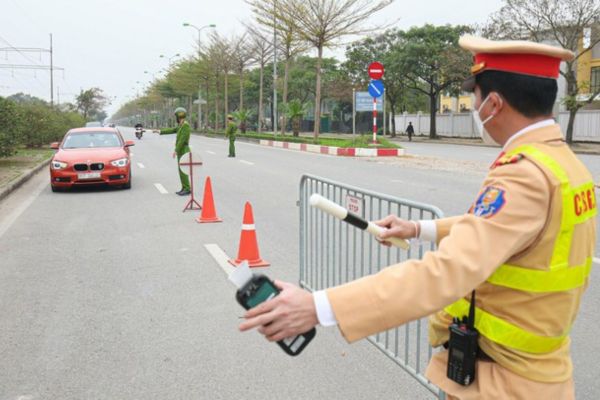Traffic Police in Plain Clothes: Are They Authorized to Penalize Traffic Violations According to Regulations?
Can Traffic Police Wear Plain Clothes to Penalize Traffic Violations?
Pursuant to the provisions under Article 11 Circular 32/2023/TT-BCA, the regulation is as follows:
Public Patrol Combined with Plainclothes Surveillance
1. The traffic police team is arranged with a section of plainclothes officers, who cooperate with public patrol and control officers according to plans issued by competent authorities as stipulated in Clause 3 of this Article to carry out patrol duties, control, and handle violations in the assigned routes and areas.
2. Cases where public patrol combined with plainclothes surveillance is applicable, include:
a) Using technical and operational means and equipment to enhance the effectiveness of ensuring road traffic order and safety;
b) Crime prevention and control; handling complex situations of security, order, or road traffic safety.
3. Authority to decide on public patrol combined with plainclothes surveillance:
a) The Director of the Traffic Police Department; the Provincial Police Chief or higher authorities decide on public patrol combined with plainclothes surveillance as stipulated in Clause 2 of this Article;
b) The Head of the Department of Road and Railway Traffic Patrol Guidance; the Head of the Traffic Police Department; the District Police Chief decide on public patrol combined with plainclothes surveillance in the cases stipulated in Point a, Clause 2 of this Article.
....
According to the above regulation, traffic police are not allowed to wear plain clothes to penalize traffic violations.
Instead, they are only allowed to wear plain clothes and cooperate with public patrol and control officers according to plans issued by competent authorities to carry out patrol duties, control, and handle violations in the assigned routes and areas.
Authority to decide on public patrol combined with plainclothes surveillance as follows:
| Case of Wearing Plain Clothes | Authority to Decide || --- | --- || Using technical and operational means and equipment to enhance the effectiveness of ensuring road traffic order and safety | The Director of the Traffic Police Department; the Provincial Police Chief or higher authorities decide on public patrol combined with plainclothes surveillance.
The Head of the Department of Road and Railway Traffic Patrol Guidance; the Head of the Traffic Police Department; the District Police Chief decide on public patrol combined with plainclothes surveillance. || Crime prevention and control; handling complex situations of security, order, or road traffic safety | The Director of the Traffic Police Department; the Provincial Police Chief or higher authorities decide on public patrol combined with plainclothes surveillance. |

Can traffic police wear plain clothes to penalize traffic violations? (Image from Internet)
What Does the Traffic Police Patrol Include?
According to the provisions under Clause 1, Article 12 Circular 32/2023/TT-BCA, the traffic police patrol includes:
- Observing and understanding the traffic order and safety situation on the road network; preventing violations, traffic accidents, and congestion; maintaining road traffic order and safety;
- Detecting, preventing, and handling violations of road traffic laws and other relevant laws as stipulated;
- Ensuring traffic order, safety, and security on the road network;
- Assisting and supporting people and vehicles participating in road traffic when necessary;
- Performing other tasks assigned by competent authorities as stipulated.
What Does the Traffic Police Control Include?
According to the provisions under Clause 2, Article 12 Circular 32/2023/TT-BCA, the regulation is as follows:
Content of Patrol and Control
....
2. Control Content
a) Control of documents related to people and vehicles, including:
Driver’s license; Certificates of law knowledge on road traffic, specialized vehicle operation certificates; Vehicle registration or a notarized copy of vehicle registration with the original receipt from the credit institution that retains the original vehicle registration (while the credit institution retains the original document); Safety inspection certificates, safety inspection seals, environmental protection, and time-limit confirmation documents for the inspection certificate and seal (for vehicles that require inspection); Compulsory civil liability insurance certificate of motor vehicle owners and other necessary documents as stipulated (hereinafter referred to as documents). When databases are connected to the electronic identification and authentication system, allowing the information verification of documents, the control can be done by checking the information in the electronic identification account which holds the same value as direct document inspection;
b) Control of the conditions for vehicle participation in traffic
Control is carried out from front to back, left to right, outside to inside, top to bottom, including: Shape, dimensions, paint color, front, rear, and side license plates of the vehicle; safety technical conditions and environmental protection of road motor vehicles, specialized motorbikes as stipulated;
c) Control of compliance with road transport safety regulations
Control the legality of goods, type, weight, quantity, specifications, dimensions; items; the actual number of people carried compared to the permitted number and other measures to ensure road transport safety;
d) Control of other relevant contents according to legal provisions
Control by traffic police includes the contents as stipulated above.
Circular 32/2023/TT-BCA will be effective from September 15, 2023.
LawNet